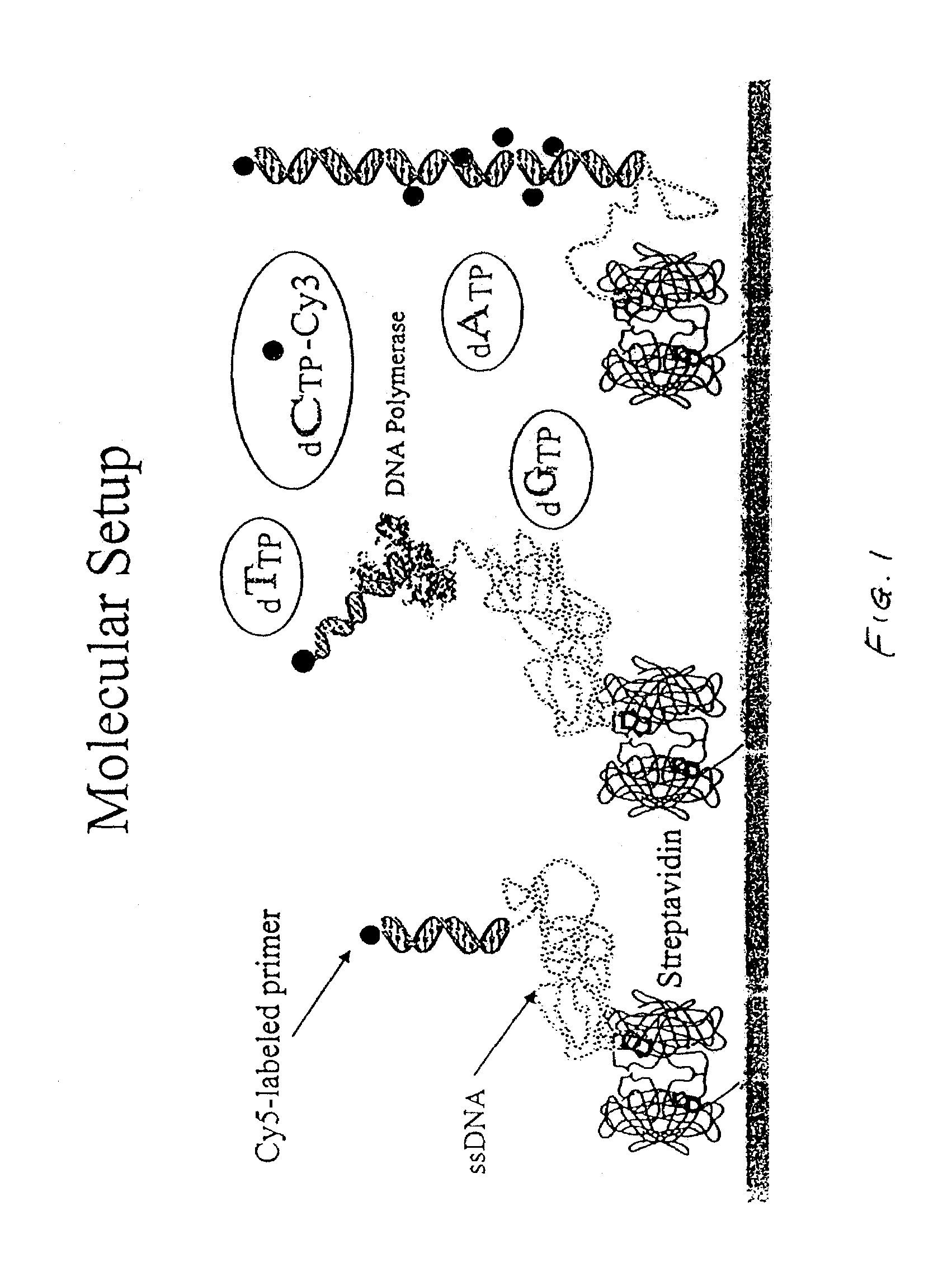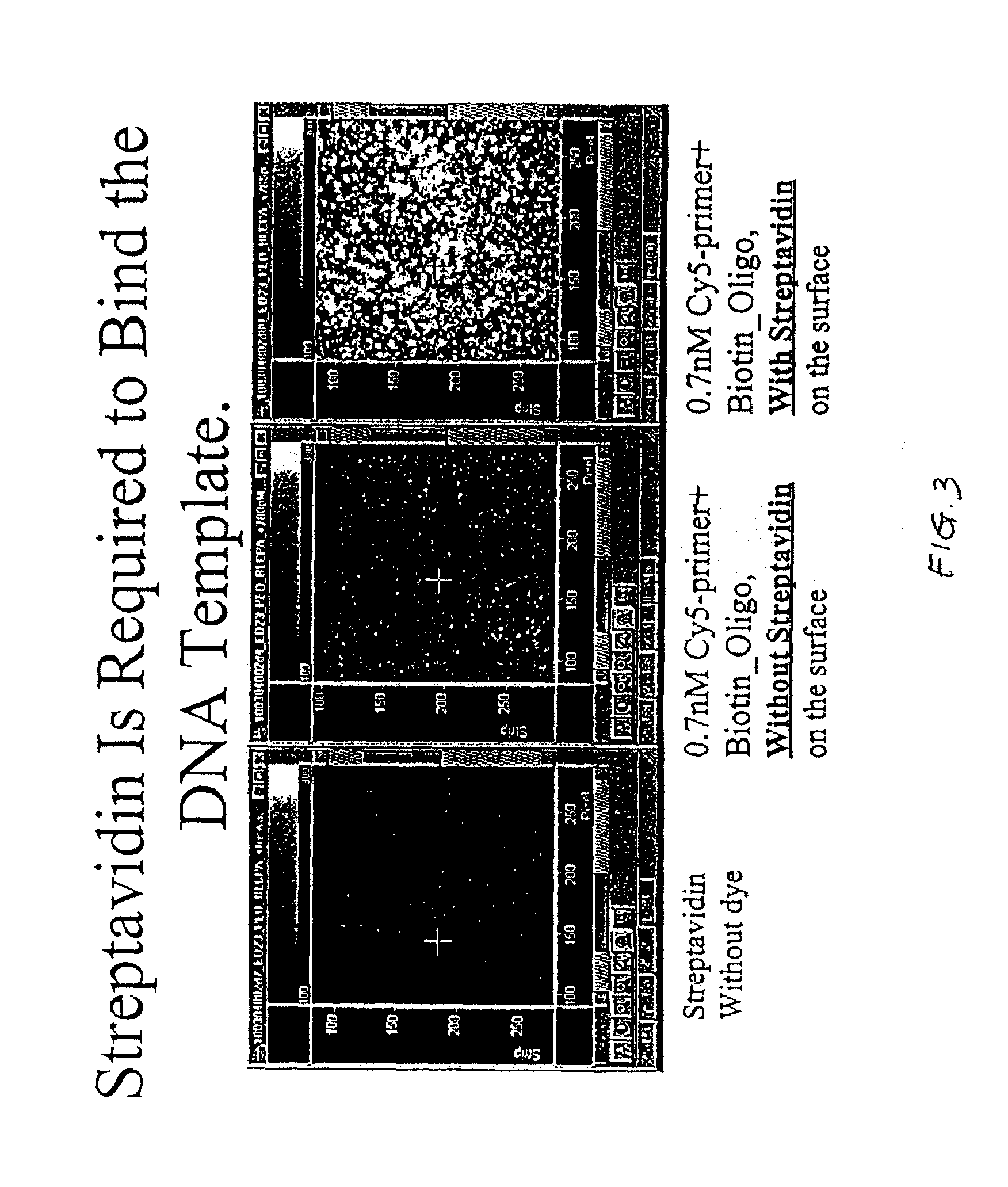Methods and apparatus for analyzing polynucleotide sequences by asynchronous base extension
a polynucleotide sequence and asynchronous base extension technology, applied in the field of methods and apparatus for analyzing polynucleotide sequences, can solve the problems of limited ability to read long sequences and time-consuming processes, and achieve the effect of facilitating the monitoring of incorporation
- Summary
- Abstract
- Description
- Claims
- Application Information
AI Technical Summary
Benefits of technology
Problems solved by technology
Method used
Image
Examples
example 1
Basic Materials and Methods
1. Materials and Reaction Reagents
[0125](1) Solutions and buffers[0126]RCA: H2O:NH4OH:H2O2 (6:4:1) boiling for an hour.[0127]PEI: PolyEthylenImine (Sigma P-3143) (positive charged)[0128]PALL: Poly(allylamine hydrochloride) (Sigma 283223)[0129]PACr: Poly(acrylic acid, sodium salt) (Sigma 416045) (negative charged)[0130]EDC: 9.6 mg / ml; 50 mM (×10) 1-{3-(Dimethylamino)propyl]-3-ethylcarbodiimide,[0131]hydrochloride), Activator for the BLCPA (Sigma-161462)[0132]BLCPA: EZ-Link Biotin LC-PEO-Amine (Pierce 21347)[0133]Stock solution 50 mM in MES 10 mM (21 mg / ml) (×10)[0134]Streptavidin plus—1 mg / ml in Tris. PROzyme, Code: SA20 (×10)[0135]Buffers:[0136]MES (N-morpholinoethanesulfonic acid) PH 5.5 1M (100×)[0137]TRIS 10 mM[0138]TRIS-MgCl2 10 mM Tris, 100 mM MgCl2 (×1)[0139]TKMC (10 mM Tris•HCl, 10 mM KCl, 10 mM MgCl2, 5 mM Ca Cl2, pH 7.0)[0140]EcoPol: 10 mM Tris•HCl, 5 mM MgCl2, 7.5 mM DTT pH@ 25° C.; buffer come with the polymerase at (×10)[0141](2) Other material...
example 2
Test for Specific Attachment of Template Molecules to Substrate Surface
[0162]This experiment was performed to determine whether the polynucleotide templates are attached to the surface as desired. FIG. 3 shows that streptavidin is required for binding the template to the surface and hence detection of incorporated fluorescence signal. The left panel shows that there is no fluorescence signal when only streptavidin-attached surface but no fluorescent labels were present. The middle panel shows that there is no incorporated fluorescent signals when no streptavidin was present on the surface to attach biotin-labeled oligonucleotide template, even though Cy5-labeled primer was present. The right panel shows that detection of incorporated fluorescent signal when the streptavidin-attached surface, labeled primers, and biotin-labeled oligonucleotide template were present.
example 3
Determining Processivity of DNA Polymerase in the Presence of Labeled Nucleotides
[0163]To determine whether the DNA polymerase accurately incorporates labeled nucleotides into the template, a bulk extension experiment was performed in a test tube rather than on the surface of a substrate. As shown in FIG. 5, the results indicate that the polymerase incorporate all the labeled nucleotides into the correct positions. In this experiment, incorporation of dCTP-Cy3 and a polymerization terminator, ddCTP, were detected using a 7G DNA template (a DNA strand having a G residue every 7 bases; SEQ ID NO:1). The annealed primer was extended in the presence of non-labeled dATP, dGTP, dTTP, Cy3-labeled dCTP, and ddCTP. The ratio of Cy3-dCTP and ddCTP was 3:1. The reaction products were separated on a gel, fluorescence excited, and the signals detected, using an automatic sequencer ABI-377. The results reveal that incorporation of Cy3-dCTP did not interfere with further extension of the primer al...
PUM
| Property | Measurement | Unit |
|---|---|---|
| surface area | aaaaa | aaaaa |
| Tm | aaaaa | aaaaa |
| temperature | aaaaa | aaaaa |
Abstract
Description
Claims
Application Information
 Login to View More
Login to View More - R&D
- Intellectual Property
- Life Sciences
- Materials
- Tech Scout
- Unparalleled Data Quality
- Higher Quality Content
- 60% Fewer Hallucinations
Browse by: Latest US Patents, China's latest patents, Technical Efficacy Thesaurus, Application Domain, Technology Topic, Popular Technical Reports.
© 2025 PatSnap. All rights reserved.Legal|Privacy policy|Modern Slavery Act Transparency Statement|Sitemap|About US| Contact US: help@patsnap.com



